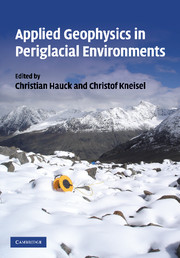Book contents
2 - Electromagnetic methods
Published online by Cambridge University Press: 22 August 2009
Summary
Introduction
Electromagnetic (EM) methods have been widely used in studies of lowland arctic permafrost (e.g. Hoekstra and McNeill 1973, Sartorelli and French 1982, Rozenberg et al. 1985, Harada et al. 2000) and studies of sea ice thickness determination (Haas 2004), including airborne applications (Fraser 1978, Pfaffling et al. 2004). Applications of EM methods in mountainous regions are less frequent (Schmöller and Frühwirth 1996, Hauck et al. 2001, Beylich et al. 2003, Bucki et al. 2004, Maurer and Hauck 2007), but have been increasing in recent years. Electromagnetic techniques include frequency-domain EM systems (FEM), time-domain electromagnetic systems (TDEM), systems using very low frequencies (VLF) and the so-called radiomagnetotelluric method (RMT).
Similar to the electrical methods (see Chapter 1) the physical parameter allowing a differentiation between ice and water or frozen and unfrozen substratum is the electrical resistivity (in ohm metres, Ω m) or more commonly its reciprocal, the electrical conductivity (in siemens/metre or usually millisiemens/metre, mS/m). A marked increase in resistivity (or decrease in conductivity) with decreasing temperature near the freezing point has been shown in many previous field studies (e.g. Hoekstra et al. 1975, Seguin 1978, Rozenberg et al. 1985) and laboratory studies (e.g. Olhoeft 1978, Pandit and King 1978, King et al. 1988, see also Chapter 7). For the major part of the commonly used frequency range, this characteristic physical property is independent of the measurement electromagnetic frequency; however, the absolute conductivity values are frequency dependent and differ strongly for different materials and unfrozen pore water contents (Hoekstra and McNeill 1973, Olhoeft 1978).
Information
- Type
- Chapter
- Information
- Applied Geophysics in Periglacial Environments , pp. 28 - 56Publisher: Cambridge University PressPrint publication year: 2008
References
Accessibility standard: Unknown
Why this information is here
This section outlines the accessibility features of this content - including support for screen readers, full keyboard navigation and high-contrast display options. This may not be relevant for you.Accessibility Information
- 3
- Cited by
